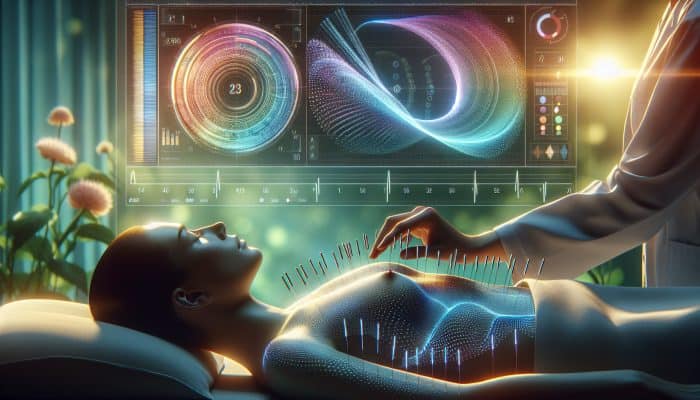Maximising Health Benefits through the Integration of Acupuncture and Biofeedback Therapy
Understanding the Synergistic Relationship Between Acupuncture and Biofeedback

The fusion of acupuncture and biofeedback therapy marks a groundbreaking method that combines the time-honoured practice of traditional healing with cutting-edge technological advancements. This innovative approach is designed to enhance therapeutic outcomes by enabling practitioners to customise treatments according to the unique physiological responses of each patient. Stemming from the principles of traditional Chinese medicine, acupuncture has been utilised for centuries to stimulate specific acupoints on the body, promoting natural healing and re-establishing balance. The incorporation of biofeedback, which employs electronic monitoring systems to deliver real-time insights into health parameters, empowers patients to engage actively in their therapeutic journey, enriching their overall experience and outcomes.
During acupuncture treatments, biofeedback devices are utilised to monitor critical physiological indicators, including heart rate variability, muscle tension, and skin temperature. This data is invaluable, allowing practitioners to make immediate adjustments to their acupuncture techniques to maximise therapeutic effectiveness. This dual approach not only enhances treatment efficacy but also deepens the patient’s understanding of their health, fostering a highly personalised and interactive therapeutic experience that can significantly improve health outcomes.
Discovering the Multifaceted Advantages of Acupuncture Combined with Biofeedback Therapy
The integration of acupuncture and biofeedback therapy presents a plethora of benefits that far exceed the capabilities of either technique when used independently. A paramount advantage is the enhanced ability to manage chronic pain more effectively. Conditions such as arthritis and fibromyalgia often necessitate complex treatment strategies; the incorporation of biofeedback allows practitioners to delve into the intricacies of each patient's pain response, facilitating more precise and targeted interventions tailored to their individual needs and circumstances.
Moreover, stress reduction stands out as a significant benefit of this combined therapy. Acupuncture is widely recognised for its calming effects, and when coupled with biofeedback, patients can learn to better regulate their stress responses. For instance, individuals undergoing treatment can observe real-time fluctuations in their stress levels throughout acupuncture sessions, equipping them with essential tools to manage anxiety more effectively beyond the clinical environment. This empowerment is crucial for fostering lasting improvements in mental health.
Additionally, this synergistic therapy has demonstrated remarkable potential in enhancing overall well-being. By addressing both the physical and psychological dimensions of health, individuals frequently report improvements in mood, better sleep quality, and increased energy levels. This holistic approach not only alleviates symptoms but also cultivates a profound sense of vitality and health, leading to long-term benefits for patients.
A Historical Perspective on the Evolution of Acupuncture in the UK
The practice of acupuncture boasts a rich history, with its roots tracing back over 2,500 years to China. However, its introduction to the UK has witnessed significant evolution. The late 20th century marked a surge of interest in alternative therapies, paving the way for a gradual acceptance of acupuncture within the national healthcare framework. Practitioners in the UK began to merge traditional methods with contemporary scientific insights, fostering innovative practices that include the integration of acupuncture with biofeedback therapy.
In recent years, the National Health Service (NHS) has recognised acupuncture as a legitimate treatment option for specific conditions, particularly in managing chronic pain and migraines. The advent of biofeedback technology further enriches this practice, aligning with the UK's commitment to evidence-based healthcare. As patients increasingly seek personalised and effective treatment options, the combination of acupuncture and biofeedback therapy emerges as a compelling alternative, harmonising ancient wisdom with modern science in a way that resonates with the ethos of British healthcare.
In-Depth Exploration of the Mechanisms Behind Acupuncture with Biofeedback Therapy

The Scientific Principles Underpinning Acupuncture
Acupuncture operates on the fundamental principle of stimulating specific points, known as acupoints, along the body's intricate meridians. These acupoints correspond to various organs and bodily systems; stimulating them is believed to harmonise the flow of energy, or Qi. Numerous studies support this concept, demonstrating that acupuncture can trigger the release of endorphins and modify brain chemistry, resulting in pain alleviation and enhanced emotional well-being.
When acupuncture needles are inserted, they create micro-traumas that stimulate the body’s intrinsic healing mechanisms. This response can be considerably enhanced through the application of biofeedback. By continuously tracking physiological responses, practitioners gain crucial insights into how the body reacts in real time, allowing for modifications in needle placement, depth, and duration based on individual feedback. This customised approach not only reassures patients of a responsive treatment but also optimises healing potential.
Research has indicated that acupuncture positively influences the autonomic nervous system, promoting relaxation and diminishing the body's stress response. This foundational understanding is vital, as it lays the groundwork for incorporating biofeedback, which enables patients to comprehend how acupuncture impacts their physiological states, thereby fostering a more engaged and informed healing process.
Deciphering the Functionality of Biofeedback Mechanisms
Biofeedback mechanisms empower patients with real-time insights into their physiological processes, which are typically involuntary. Common parameters measured include heart rate, muscle tension, and skin conductivity, all of which yield valuable information about the body's stress responses. This insight allows patients to directly observe the effects of acupuncture on their bodily functions, creating an interactive and educational experience that enhances the overall therapeutic journey.
For example, during an acupuncture session, a patient may notice a decrease in muscle tension as indicated by the biofeedback monitor when needles are strategically placed. This immediate feedback can reinforce the treatment's effectiveness, motivating patients to adopt complementary relaxation techniques that enhance their acupuncture experience. By learning to manage these physiological responses, individuals can significantly improve their emotional and physical well-being.
Moreover, biofeedback techniques can transcend the treatment room. Patients can implement the strategies learned to manage stress levels and pain responses in their everyday lives, utilising insights gained from their sessions. This self-regulation fosters a greater sense of control over one’s health, which is a crucial factor in attaining long-term wellness goals.
The Profound Synergy of Merging Acupuncture and Biofeedback

The integration of acupuncture and biofeedback generates a synergistic effect that magnifies the benefits of both therapies. The real-time feedback derived from biofeedback technology empowers practitioners to make immediate adjustments to acupuncture techniques, thus amplifying their overall effectiveness. For instance, if a patient's biofeedback reveals elevated stress levels during treatment, the practitioner can modify their approach to directly address those specific stress responses, enhancing the therapeutic outcome.
This synergy also encourages patient empowerment. By visualising how acupuncture influences their bodily functions, patients are more motivated to actively engage with their treatment plans. They learn to identify their stress triggers and can employ relaxation techniques that have proven effective during their sessions, leading to sustained benefits that extend beyond the clinical environment.
The clinical applications of this combined therapy are extensive, addressing a wide range of conditions. This integrated approach is particularly advantageous for chronic pain management, as it simultaneously tackles both the physiological and psychological facets of pain. This holistic methodology results in significantly improved patient outcomes compared to traditional treatment modalities.
Diverse Clinical Applications of Acupuncture with Biofeedback Therapy and Their Advantages
The clinical applications of acupuncture combined with biofeedback are vast and encompass numerous health conditions. Chronic pain management stands out as one of the most significant areas where this synergistic therapy has demonstrated remarkable effectiveness. Conditions like arthritis, fibromyalgia, and back pain often require comprehensive treatment strategies. The integration of biofeedback allows practitioners to tailor their approaches, ensuring that each patient's unique pain experience is addressed holistically and effectively, leading to better health outcomes.
Beyond pain management, this therapy has shown promising results in alleviating stress. The calming effects of acupuncture can be amplified by biofeedback, which aids patients in understanding their stress responses and developing self-regulation techniques. By equipping individuals with tools to manage anxiety and stress, acupuncture combined with biofeedback not only alleviates symptoms but also fosters enduring mental health benefits that can enhance overall life satisfaction.
Moreover, this combined therapy is increasingly recognised in the treatment of neurological disorders. Patients suffering from migraines, Parkinson's disease, or those recovering from strokes have reported significant improvements in their symptoms and overall quality of life. The ability to monitor physiological responses in real time allows practitioners to dynamically adjust treatment strategies, ensuring optimal outcomes for patients navigating the complexities of neurological conditions.
Successfully Managing Conditions with Acupuncture and Biofeedback Therapy
Innovative Approaches for Chronic Pain Management
Chronic pain is a prevalent affliction affecting millions in the UK, presenting in various forms, including arthritis, fibromyalgia, and persistent back pain. The combination of acupuncture and biofeedback therapy provides a comprehensive method for managing these debilitating conditions. By leveraging acupuncture to stimulate specific points associated with pain pathways and complementing it with biofeedback monitoring, practitioners can significantly enhance the effectiveness of their treatments, leading to improved patient experiences.
Research has indicated that patients suffering from chronic pain who undergo this combined therapy experience substantial pain relief. The real-time feedback provided through biofeedback enables immediate adjustments in treatment, ensuring that acupuncture techniques are specifically tailored to each individual's needs. This personalised approach not only alleviates pain but also enhances mobility and overall functionality, empowering patients to engage more fully in their daily activities.
Additionally, the psychological dimensions of chronic pain must not be overlooked. Chronic pain can often lead to anxiety and depression, creating a detrimental cycle that exacerbates the pain experience. The integration of biofeedback techniques empowers patients to develop coping strategies, enhancing their ability to manage pain and reduce associated emotional distress. Ultimately, this combined therapy serves as a potent tool for restoring and enhancing quality of life.
Proven Strategies for Alleviating Stress and Anxiety
In today’s fast-paced world, stress and anxiety have become ubiquitous, impacting both mental and physical health. Acupuncture with biofeedback therapy provides a dual approach to managing these challenges. Acupuncture induces a state of relaxation by stimulating the body’s natural healing mechanisms, while biofeedback offers patients insights into their stress responses, empowering them to learn how to effectively manage these reactions.
The relaxing effects of acupuncture are well-documented, and when combined with biofeedback, patients gain a deeper understanding of their stress triggers and bodily responses. For instance, a patient may observe a decrease in heart rate or muscle tension during sessions, reinforcing the positive effects of acupuncture. This feedback encourages patients to engage in relaxation techniques, mindfulness practices, and other coping strategies that can be employed in everyday situations, ultimately leading to improved mental health.
Regular sessions of acupuncture combined with biofeedback can lead to significant improvements in mental health. Patients frequently report reduced anxiety levels, enhanced sleep quality, and increased emotional resilience. This holistic approach not only addresses the immediate symptoms of stress but also cultivates a greater sense of overall well-being, allowing individuals to navigate life’s challenges with greater ease and confidence.
Progressive Therapy for Neurological Disorders
Acupuncture with biofeedback is gaining recognition for its potential benefits in treating neurological disorders. Conditions such as migraines, Parkinson's disease, and recovery from strokes often present complex challenges that necessitate multifaceted treatment strategies. This combined therapy facilitates tailored interventions that address both the physiological and psychological dimensions of these conditions, leading to more effective treatment outcomes.
Research indicates that acupuncture can significantly assist in managing migraines by reducing both the frequency and intensity of attacks. When integrated with biofeedback, patients can identify potential triggers and manage their responses effectively, enhancing their overall ability to cope. Biofeedback not only amplifies the efficacy of acupuncture but also empowers individuals to take a more active role in their treatment journey.
In the context of Parkinson's disease, acupuncture combined with biofeedback can alleviate symptoms such as tremors and muscle stiffness. By providing real-time monitoring of physiological responses, practitioners can dynamically adjust treatment plans to optimise patient outcomes. This personalised care is crucial for individuals navigating the complexities of neurological disorders, as it specifically addresses their unique experiences and needs, ultimately leading to enhanced quality of life.
Moreover, patients recovering from strokes have reported improvements in mobility, speech, and overall quality of life following acupuncture combined with biofeedback therapy. The blend of traditional techniques with modern technology fosters a comprehensive approach to rehabilitation, promoting both physical and emotional recovery within a supportive environment.
Choosing the Right Practitioner for Acupuncture with Biofeedback Therapy in the UK
Essential Qualifications to Consider
When searching for an acupuncture practitioner who also specialises in biofeedback therapy within the UK, several essential qualifications should be taken into account to ensure a safe and effective treatment experience. To begin with, it is imperative to select practitioners who are registered with the British Acupuncture Council (BAcC). Membership in this esteemed professional organisation signifies that the practitioner has met specific training and ethical standards, ensuring a high level of care and professionalism.
Furthermore, it is vital to find practitioners who have received specialised training in biofeedback techniques. This dual expertise is crucial for effectively integrating both therapies during treatment sessions. Many practitioners may also hold additional certifications or training in complementary therapies, enhancing their capability to provide a holistic approach to patient care.
Researching the practitioner’s background, including their education, experience, and patient reviews, is advisable. By selecting a practitioner with a strong professional reputation and a proven track record, patients can feel more confident in their treatment journey. Personal recommendations from friends or family can also be invaluable in identifying a qualified practitioner who meets your specific needs.
Accessing Acupuncture with Biofeedback Services
Acupuncture with biofeedback therapy is widely available across the UK, with services offered in a variety of settings, including private clinics, NHS pain management centres, and wellness centres. Many practitioners operate within holistic health practices, which may also provide additional complementary therapies, such as massage and nutritional counselling.
The NHS increasingly acknowledges acupuncture as a valid treatment for certain conditions, leading to the establishment of pain management clinics that incorporate acupuncture alongside conventional medical care. Patients may find that their GP can refer them to these services, thus enhancing accessibility to effective treatments.
Online directories and practitioner databases, such as the BAcC’s website, can also serve as useful resources for locating qualified practitioners in your area. Many practitioners maintain a presence on social media and professional websites, where they share information about their services, specialisations, and patient testimonials. Exploring these resources can assist individuals in finding the right practitioner to meet their unique needs and preferences.
What to Anticipate During an Acupuncture with Biofeedback Session
Participating in an acupuncture with biofeedback session involves several key steps that are integral to the treatment process. Initially, patients can expect a thorough consultation, during which the practitioner will gather detailed information about their medical history, current symptoms, and treatment objectives. This information is essential for developing a personalised treatment plan tailored to the individual’s specific needs and preferences.
During the session, practitioners typically insert acupuncture needles at designated points based on the initial assessment. Following this, biofeedback devices are employed to monitor physiological responses, providing both the practitioner and patient with real-time insights into how the body is reacting to the treatment. This feedback loop is invaluable, enabling immediate adjustments to the acupuncture approach as needed, ensuring optimal therapeutic outcomes.
Patients should anticipate a relaxed atmosphere throughout their sessions, designed to foster a calming environment conducive to healing. Many practitioners utilise relaxation techniques, such as guided breathing exercises, to help patients maximise the benefits of treatment. Overall, the experience is structured to empower individuals, allowing them to take an active role in their health and well-being through the integration of acupuncture and biofeedback therapy.
Inspiring Success Stories from the UK
Case Studies Highlighting Effective Pain Management
Numerous case studies from the UK illustrate the efficacy of acupuncture with biofeedback therapy in managing chronic pain. For example, a 45-year-old woman suffering from fibromyalgia underwent a series of combined therapy sessions. Initially struggling with widespread pain and fatigue, she reported substantial improvements after just a few sessions. The real-time feedback provided through biofeedback technology allowed her practitioner to optimise the acupuncture techniques based on her physiological responses, leading to significant pain relief.
Throughout her treatment, her pain levels significantly decreased, and she regained mobility that had been compromised for years. This case exemplifies how the integration of acupuncture with biofeedback can lead to tangible enhancements in the quality of life for individuals with chronic pain conditions, showcasing its potential as a vital therapeutic option.
Another case involved a middle-aged man with chronic lower back pain resulting from a previous injury. Following several sessions of acupuncture with biofeedback therapy, he reported marked reductions in pain and an increased capacity to engage in physical activities he had previously avoided. The biofeedback monitoring allowed the practitioner to dynamically adjust the treatment plan, thereby enhancing its effectiveness and supporting his recovery journey.
Positive Outcomes in Stress Reduction
Acupuncture with biofeedback therapy has also yielded remarkable results in stress relief. A case study involving a young professional dealing with severe anxiety highlights the transformative potential of this combined approach. After just a few sessions, she reported a significant decrease in anxiety levels, along with improved stress management skills and coping strategies.
The biofeedback component of her treatment provided insights into her physiological responses during stressful situations, equipping her with techniques to manage her anxiety more effectively. She described feeling empowered by the knowledge gained from her sessions, which enabled her to incorporate relaxation techniques into her daily life, ultimately leading to a greater sense of calm and emotional resilience.
Another case involved a student experiencing acute exam stress. After undergoing acupuncture and biofeedback therapy, he reported feeling more relaxed and focused, which resulted in improved performance during his examinations. This case underscores the efficacy of the combined therapy in addressing mental health challenges, equipping patients with essential tools to navigate life's stressors and achieve their academic goals.
Rehabilitation Success Stories for Neurological Conditions
Individuals recovering from neurological events have also experienced significant benefits from acupuncture with biofeedback therapy. A notable case involved a patient who had suffered a stroke, resulting in considerable mobility and speech impairments. Through a tailored treatment plan that integrated acupuncture and biofeedback, this individual witnessed remarkable improvements in motor function and speech clarity over several weeks, enabling them to regain independence.
The biofeedback technology enabled the practitioner to monitor the patient’s progress and adapt the treatment accordingly, ensuring that the most effective techniques were utilised throughout the rehabilitation process. Consequently, the patient reported increased independence and a profound enhancement in quality of life, showcasing the transformative impact of this combined therapy.
Another success story features a patient with Parkinson's disease, who experienced severe tremors. After undergoing the combined therapy, he reported reduced tremors and improved control over his movements. The integration of biofeedback provided valuable insights that guided the acupuncture treatment, reinforcing the efficacy of the combined approach in addressing complex neurological conditions and enhancing overall well-being.
Research and Evidence Supporting Acupuncture with Biofeedback in the UK
Findings from Clinical Trials
In the UK, numerous clinical trials have investigated the efficacy of acupuncture with biofeedback therapy for various health conditions. These studies have produced promising results, demonstrating that this combined approach offers enhanced outcomes for patients suffering from chronic pain, stress, and neurological disorders. The evidence gathered supports the effectiveness of integrating these therapies in clinical practice.
For example, a recent trial focused on individuals with chronic lower back pain found that those receiving acupuncture with biofeedback reported significantly greater pain relief and improved functionality compared to those receiving standard care alone. These findings suggest that integrating biofeedback can optimise the effectiveness of acupuncture, establishing it as a valuable component of comprehensive pain management strategies.
Another trial assessed the impact of this combined therapy on anxiety and stress levels among individuals diagnosed with generalized anxiety disorder. Results indicated that participants undergoing acupuncture with biofeedback experienced substantial reductions in anxiety symptoms and improved overall well-being, reinforcing the therapeutic benefits of this integrative approach. Clinical trials like these provide a solid evidence-based foundation for the increasing acceptance of acupuncture with biofeedback within mainstream healthcare.
Insights from Peer-Reviewed Research
The body of research supporting the combination of acupuncture with biofeedback continues to grow, with numerous peer-reviewed studies published in reputable UK journals. These studies underscore the benefits of integrating traditional acupuncture techniques with modern biofeedback technology, reinforcing the effectiveness of this approach in addressing a variety of health concerns.
One such study revealed that patients receiving acupuncture combined with biofeedback for chronic pain not only experienced significant pain relief but also reported improvements in quality of life and mental health. The results emphasise the importance of integrating therapeutic modalities to achieve optimal patient outcomes, further validating the benefits of this combined therapy.
Another peer-reviewed article investigated the impact of acupuncture combined with biofeedback on stress management. The findings indicated that participants exhibited significant improvements in stress resilience and emotional regulation, underlining the therapeutic potential of this integrated approach in enhancing mental health and overall well-being.
These studies reflect the growing recognition within the medical community of the value of acupuncture with biofeedback as a complementary treatment option. As more evidence emerges, the integration of these therapies into standard healthcare practices is likely to become increasingly prevalent, benefiting patients seeking holistic care.
Expert Perspectives on Acupuncture with Biofeedback
Healthcare professionals across the UK are increasingly endorsing acupuncture with biofeedback therapy as a complementary treatment for various conditions. Experts highlight the benefits of this integrated approach, noting that the combination allows for a more personalised and effective treatment experience tailored to individual needs.
Many practitioners have observed that patients exhibit better responses to treatment when their physiological responses are monitored through biofeedback. This feedback not only enhances the efficacy of acupuncture but also empowers patients to take an active role in their health journey, fostering greater engagement and commitment to their treatment plans.
Additionally, experts advocate for increased awareness and education surrounding acupuncture with biofeedback, emphasising its potential to improve patient outcomes across a range of conditions, including chronic pain, stress, and neurological disorders. The collective support from healthcare professionals strengthens the credibility of this therapy and its role in the evolving landscape of holistic healthcare.
Government Recognition and Reports
UK government health reports have begun to acknowledge the benefits of acupuncture with biofeedback in enhancing patient outcomes. Recognising the growing body of evidence supporting this combined therapy, policymakers are considering its integration into broader healthcare protocols, which may lead to increased accessibility for patients.
These reports emphasise the importance of complementary therapies in enhancing the effectiveness of conventional medical treatments. By embracing acupuncture with biofeedback, the UK healthcare system may better address the diverse needs of patients, particularly those grappling with chronic pain and mental health challenges.
As awareness of the potential benefits of acupuncture with biofeedback continues to expand, there is optimism for increased funding and support for research in this area. Government acknowledgment of the value of these therapies could pave the way for broader access and integration into mainstream healthcare practices, ultimately benefitting patients seeking holistic solutions.
Insights from Patient Surveys
Patient surveys conducted among individuals who have undergone acupuncture with biofeedback therapy in the UK reveal impressive satisfaction rates. Many respondents report significant improvements in their symptoms, quality of life, and overall well-being following treatment, highlighting the positive impact of this integrated approach.
Feedback from patients underscores the empowering nature of biofeedback, enabling them to gain a deeper understanding of their health and responses to treatment. Participants often express appreciation for the personalised approach provided by practitioners, emphasising the value of tailored treatment plans that address their unique needs and preferences.
Overall, these surveys indicate a robust demand for acupuncture with biofeedback therapy, suggesting that patients are increasingly seeking this integrated approach to manage chronic conditions and enhance their quality of life. The positive feedback from patients reinforces the efficacy and relevance of this therapy in today’s healthcare landscape, showcasing its potential as a valuable resource for those in need.
Integrating Complementary Practices with Acupuncture and Biofeedback Therapy
Enhancing Health through Holistic Approaches
Combining acupuncture with biofeedback therapy provides a holistic framework that can be further enhanced by incorporating complementary practices. Techniques such as mindfulness, meditation, and gentle physical exercises like yoga can significantly improve patient outcomes when used alongside these therapies. Mindfulness and meditation help patients cultivate a deeper awareness of their bodies and stress responses, making them more attuned to the benefits of acupuncture and biofeedback.
Incorporating these practices encourages a comprehensive approach to health and well-being, enabling patients to develop skills that extend beyond the clinic. For instance, individuals who regularly engage in mindfulness practices may find it easier to manage stress during acupuncture sessions, thereby enhancing the overall effectiveness of the treatment and fostering a more positive therapeutic experience.
Furthermore, nutritional guidance can complement acupuncture with biofeedback therapy. A balanced diet is essential in supporting overall health, and practitioners may recommend dietary adjustments to elevate treatment efficacy. By addressing lifestyle factors holistically, patients can optimise their healing journey and promote long-term well-being, ensuring the best possible outcomes from their therapies.
Future Directions for Research and Practice in Acupuncture with Biofeedback
As the field of acupuncture with biofeedback therapy continues to evolve, future research and practice will likely focus on integrating these modalities more effectively into mainstream healthcare. Ongoing clinical trials and studies are crucial for establishing robust evidence to support the efficacy of this combined approach, further validating its role in patient care.
Moreover, healthcare professionals may strive to develop standardised protocols for implementing acupuncture with biofeedback therapy in clinical settings. This could facilitate greater accessibility and acceptance within the healthcare system, ensuring that patients can benefit from this innovative therapy without barriers.
Education and training for practitioners will also be vital in advancing this practice. As more professionals become familiar with integrating biofeedback into acupuncture, the potential for improved patient outcomes will increase. Ultimately, fostering collaboration between traditional and modern healthcare approaches will create a more holistic and patient-centred healthcare landscape, benefitting individuals seeking comprehensive care.
Empowering Patients through Self-Care and Engagement
A crucial aspect of the success of acupuncture with biofeedback therapy is its ability to empower patients. By providing insights into their physiological responses, biofeedback encourages individuals to take an active role in managing their health. This empowerment can lead to improved adherence to treatment plans and a greater commitment to self-care, fostering a positive cycle of healing and wellness.
Patients who understand how their bodies react to stress and pain are better equipped to implement effective coping strategies in their daily lives. This newfound sense of agency fosters resilience and promotes a proactive approach to health, motivating individuals to seek additional resources, such as support groups, educational workshops, or further therapeutic practices that can enhance their well-being.
The integration of acupuncture with biofeedback therapy prioritises patient-centred care, ensuring that individuals feel supported and engaged throughout their healing journey. As more patients embrace this approach, the potential for improved health outcomes and overall well-being will continue to grow, underscoring the importance of holistic care in modern healthcare.
Common Questions Regarding Acupuncture with Biofeedback Therapy
What is acupuncture with biofeedback therapy?
Acupuncture combined with biofeedback therapy utilises traditional acupuncture techniques alongside modern biofeedback technology to enhance treatment outcomes. This approach enables practitioners to tailor treatments based on real-time physiological responses, maximising therapeutic effectiveness.
How does biofeedback enhance acupuncture treatment?
Biofeedback provides real-time data on physiological responses, allowing practitioners to adjust acupuncture techniques for optimal effectiveness. This personalised approach enhances patient engagement and improves treatment outcomes, leading to a more satisfying therapeutic experience.
What conditions can be treated with this therapy?
Acupuncture with biofeedback is effective for managing chronic pain, stress, anxiety, and neurological disorders. It addresses both the physical and psychological aspects of these conditions, promoting overall well-being and improving quality of life.
How do I find a qualified practitioner in the UK?
Look for practitioners registered with the British Acupuncture Council who also have training in biofeedback techniques. Services are available in private clinics, NHS pain management centres, and wellness centres, ensuring access to qualified professionals.
What can I expect during a session?
During a session, you will undergo an initial consultation followed by acupuncture treatment. Biofeedback monitoring will provide real-time insights into your physiological responses, allowing for tailored treatment adjustments that optimise your experience.
Is acupuncture with biofeedback safe?
Yes, when performed by qualified practitioners, acupuncture with biofeedback therapy is considered safe. Always consult a healthcare professional if you have concerns about your specific health conditions or treatment options.
How many sessions are typically required?
The number of sessions needed varies by individual and condition. Many patients report significant improvements within a few sessions, while others may benefit from ongoing treatment for chronic conditions, ensuring sustained outcomes and progress.
Will my insurance cover this therapy?
Insurance coverage for acupuncture with biofeedback varies. Check with your insurance provider to determine if these therapies are included in your plan, ensuring you have access to the treatment you need.
Can I combine this therapy with other treatments?
Yes, acupuncture with biofeedback can complement other treatments. Always consult your healthcare provider to ensure a coordinated approach to your care, maximising the benefits of all therapeutic options.
What are the long-term benefits of acupuncture with biofeedback?
Long-term benefits may include improved pain management, reduced stress and anxiety levels, enhanced emotional well-being, and an overall improved quality of life. Many patients also report increased self-awareness and empowerment regarding their health, leading to healthier lifestyle choices.
Connect with us on Facebook!
The Article Acupuncture with Biofeedback Therapy: A Holistic Approach Was First Published On https://acupuncture-frome.co.uk
The Article Biofeedback Therapy in Acupuncture: A Holistic Method Was Found On https://limitsofstrategy.com


The integration of acupuncture and biofeedback therapy certainly presents a fascinating dynamic in the realm of holistic healing. I find the notion of merging traditional practices with modern technology particularly intriguing, especially considering the growing trend toward personalized medicine. This approach highlights the need for treatments that not only address symptoms but also consider individual physiological responses, an insight that aligns well with the ongoing shift we’re seeing in healthcare toward patient-centered approaches.